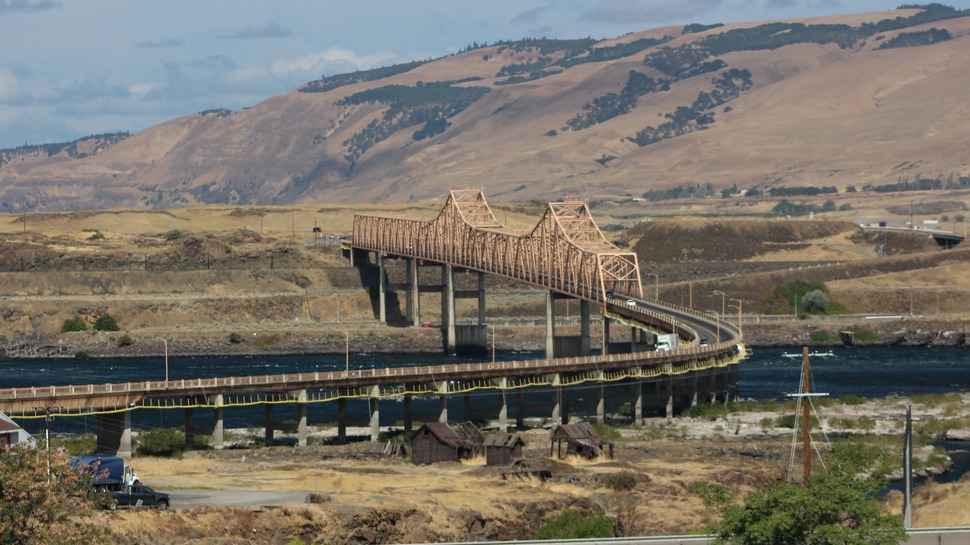
Opened just before Christmas 1953, the U.S. 197 bridge over the Columbia River was until recently typical of thousands of bridges nationwide: in need of major rehabilitation to ensure the driving public’s safety.
Average daily traffic on the two-lane bridge connecting Oregon and Washington is nearly 8,400. That’s not huge compared to the volume in urban areas, but it’s significant for commuters in a remote area with fewer bridges.
The Oregon DOT (ODOT) had three choices for replacing the steel-reinforced concrete bridge deck: poured-in-place concrete, which would take at least eight months, and precast prestressed concrete panels installed in overnight full closures or weekend full closures.
The state chose the latter as the fastest and most cost-effective option because it saves 10% to 20% on setup and cleanup costs over nighttime-only closures. Using a process known as accelerated bridge construction (ABC), sections of the old concrete deck were sawcut, lifted out with a truss crane, and placed on a self-propelled modular transporter to be removed from the jobsite. New sections formed offsite were then lowered into place with the truss.
ABC is a highly efficient, assembly line-like method for replacing a bridge deck. Public agencies use it to minimize inconvenience to the driving public by speeding project delivery.
The Problem with Portland in Cold Weather
The project was progressing as planned until a materials issue threatened to derail the schedule.
It was March when Hamilton Construction finished placing the precast concrete bridge panels and began connecting the joints. Daytime temperatures in that area of the country range from the lower 40s to lower 60s, and fall to below freezing at night.
As always, time was of the essence. Crews had from 9 p.m. to 5:30 a.m. to mix, place, finish, and cure. State specifications required joint fill material to reach 4000 psi compressive strength in four hours.
The contractor began mixing and placing the state’s specified product: an accelerated, self-consolidating ultrahigh-performance concrete (UHPC) mix of steel fibers, liquid admixtures, and a proprietary portland cement-based premix batched in a high-shear mixer.
Even after experimenting with various admixtures, though, the crew couldn’t get the material to meet the strength requirement. In addition, the company doesn’t own a high-shear mixer, and its mortar mixer kept stalling due to load.
“It was taking 18 to 24 hours to get the set we needed, and we weren't able to get subsequent loading on to the structure,” says Hamilton Construction Project Manager Evan Stuart. “Also, the material can easily be reactivated. You had to be careful; you couldn't have equipment running next to it because the vibration would keep it from setting.”
That’s when the state tried a product based on calcium sulfoaluminate (CSA) cement instead of portland cement: Rapid Set® UHPC Mortar.
Formulated for high abrasion resistance, the blend of Rapid Set® CSA cement, high-performance additives, and high-density aggregate is mixed with water to produce a pourable material that reaches 17,000 psi compressive strength in 28 days. Like all Rapid Set® products, it achieves structural strength in hours without an accelerator.
A (Really) Fast and Durable Mix Design
Because Oregon has used multiple Rapid Set® products to fast-track concrete repairs, state material engineers were familiar with CSA cement’s benefits. They approved UHPC Mortar after testing in their lab a mix extended with 3/8-inch aggregate and Helix Steel’s Helix® 5-13 Micro Rebar™ steel fiber. One cubic yard contained 2,187 pounds of mortar; 1,094 pounds of aggregate; 188 pounds of fiber; and 262 pounds of water.
After determining batching sequence, mixing took 7 minutes. No admixtures were required.
In the field, Hamilton Construction’s crew blended the materials in a mortar mixer and poured it into joints ranging from 7 inches to 10 inches. They also filled flaws and pick pockets – the holes for lifting chains – in the precast panels.
UHPC Mortar should be water-cured for at least one hour. The crew used wet burlap.
“The cure wasn’t to maintain heat,” says Stuart. “All concrete generates heat as it sets, but Rapid Set® produces quite a bit. The mortar was heating itself. We just needed to keep it wet.”
“We were hitting 9000 psi,” says Stuart of cylinder test results. “The target was 4000, so we easily hit that in four hours.”
After connecting the panels, the contractor used the mortar to fill spalls and make other cosmetic repairs to the approaches on both sides of the bridge.
“We would have struggled through with the first material if we'd had to, but the mortar was far more user-friendly,” says Hamilton Construction’s Stuart. “And it was just a better product for the application. Depending on weather conditions, the gel time on the first material is hours. Rapid Set®’s initial set is 15 to 20 minutes but it can still be worked.”
Hamilton Construction uses various Rapid Set® products, so crews are used to working with CSA cement.
“It's no different than working with portland, just faster – which is the major benefit to it,” says Stuart. “It doesn't take special tools or equipment. You just put it in your mixer, mix it up, and move on.”
Rapid Set® UHPC Mortar is available in 60-pound bags and 3,000-pound supersacks from contractor supply yards nationwide.

